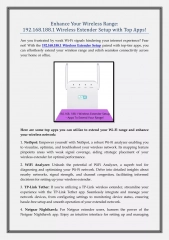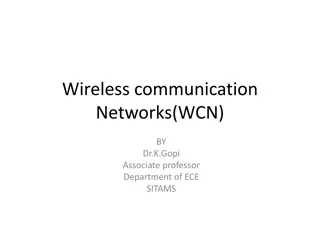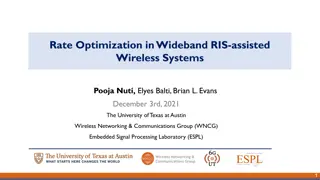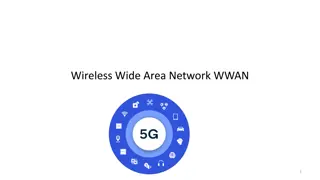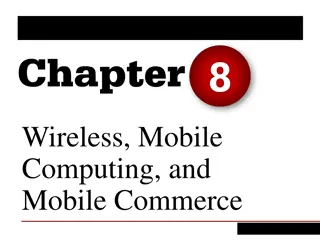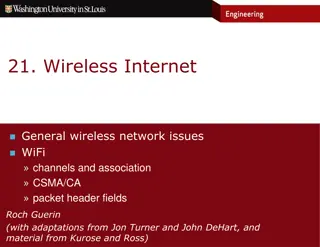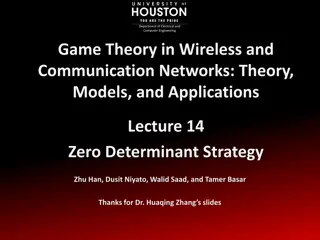
Introduction to Wireless Communication Networks and Infrastructure
"Explore the world of wireless communication networks, from general architecture to different types of systems. Learn about wired communication network infrastructure and key elements of wired networks. Discover the essential components of wireless communication infrastructure and how they interact with wired networks."
Download Presentation

Please find below an Image/Link to download the presentation.
The content on the website is provided AS IS for your information and personal use only. It may not be sold, licensed, or shared on other websites without obtaining consent from the author. If you encounter any issues during the download, it is possible that the publisher has removed the file from their server.
You are allowed to download the files provided on this website for personal or commercial use, subject to the condition that they are used lawfully. All files are the property of their respective owners.
The content on the website is provided AS IS for your information and personal use only. It may not be sold, licensed, or shared on other websites without obtaining consent from the author.
E N D
Presentation Transcript
Introduction to Wireless Network Chapter 2 1
Contents Introduction General Computer Communication Network Architecture Wired Communication Network Infrastructure Wireless Communication Network Infrastructure Different Types of Wireless Communication Systems Classification of Wireless Communication Systems Based on Coverage Based on Topology Based on Mobility Wireless Personal Area Networks Wireless Local Area Networks Wireless Wide Area Networks Summary 2
Introduction A wireless communication network is A computer network that uses a wireless connection between network nodes. A method to connect telecommunications networks, and business installations or to connect between various equipment locations, to avoid the costly process of introducing cables. Examples of wireless communication networks include Cellular networks Wireless local area networks (WLANs) Wireless ad-hoc networks Wireless sensor networks Vehicular communication networks Satellite communication networks. 3
Wired Communication Network Infrastructure User equipment in wired networks is referred to as fixed communication terminals due to limited mobility. In the early days, user equipment such as land-line telephones and desktop computers are directly connected to a network switch or a network router through physical network cables. In modern data centers and cloud computing centers, the servers are also hard wired to switches or routers. The core network consists of many switches and routers that are interconnected with physical medium, such as copper wire, Ethernet cable, fiber optics, etc. 4
Elements of a Wired Network Local Area Network Network Switch Network Router Network Fixed Communication Terminal Fixed Communication Terminal wired network infrastructure Wireless and Mobile Networks: 7- 5
Wireless Communication Network Infrastructure Most wireless communication systems only deploy wireless components at the edge of the communication infrastructure The core network in a general wireless communication infrastructure is a wired network. The wireless access is provided with extra components and resources to the core network infrastructure. Wireless transceivers: base stations, access point (AP), mobile stations (MSs), etc. Management entities: mobility management, power management, radio resource management, security management, etc. Spectrum: radio frequency bands for data transmission and possible air interface. Deployment: spectrum reuse in communications, wireless network design, etc. 6
Elements of a Wireless Network Wireless Hosts Laptop, smartphone, IoT May be stationary (non-mobile) or mobile wireless does not always mean mobility! Wired Network Infrastructure Wireless and Mobile Networks: 7- 7
Elements of a Wireless Network base station Typically connected to wired network Relay - responsible for sending packets between wired network and wireless host(s) in its area e.g., cell towers, 802.11 access points Wired Network Infrastructure Wireless and Mobile Networks: 7- 8
Elements of a Wireless Network Wireless Link Typically used to connect mobile(s) to base station, also used as backbone link Multiple access protocol coordinates link access Various transmission rates and distances, frequency bands Wired Network Infrastructure Wireless and Mobile Networks: 7- 9
Elements of Wireless Networks Ad Hoc Mode No base stations Nodes can only transmit to other nodes within link coverage Nodes organize themselves into a network: route among themselves Wireless and Mobile Networks: 7- 10
Classification of Wireless Communication Systems Wireless communication systems can be classified in several ways, based on coverage, topology, or mobility, 11
Wireless Personal Area Networks A WPAN can be used for communications among the personal devices themselves. A WPAN usually has an ad-hoc topology. Master slave mode and mesh mode are the two types of ad-hoc networks that can be applied for WPANs. A master slave ad-hoc network consists of a master node and multiple slave nodes. The master node defines a cell or piconet. The slave nodes within the piconet connect to the master device. Some WPANs apply mesh mode, where nodes are interconnected with wireless links without forming a specific cell or piconet 14
Master and Slave Ad-Hoc Mode Slave Slave Master Slave Slave Master and slave ad-hoc mode Mesh mode 15
Wireless Local Area Networks WLANs are infrastructure based wireless communication systems. They are normally built on top of a wired local area network (LAN). One of the typical WLAN settings is a home Wi-Fi, which forms one basic service set (BSS) that includes one AP and multiple user devices. The AP may have extra Ethernet ports to support wired access from servers, desktops, and other devices. A WLAN may have extended service set (ESS) that supports multiple BSSs, similar to a traditional Ethernet based LAN. All APs are interconnected, in most cases through wired connection. A user may be within the radio coverage of multiple APs, each user can connect to one BSS only at a time. 16
Architecture of WLAN Extended Service Set (ESS) The Internet AP1 AP2 Basic Service Set (BSS) 17
Wireless Wide Area Networks WWAN has the largest service coverage in all wireless communication systems. A general architecture of WWANs has different components at the radio level, the network level, and the management level. The radio level provides wireless access to user equipment, or mobile stations (MSs), which can be a mobile phone, a smart watch, a vehicle, etc. MSs access to WWAN through points of access in the infrastructure. Point of access is the physical radio transceiver. It creates the air interface and communications with MSs. Points of access could be base stations, base transceiver subsystem, mobile data base station, AP, NodeB, eNodeB, etc., depending on the wireless technology it is deployed. 18
Wireless Wide Area Networks The network level is the backbone infrastructure that connects all switches and routers in the network. A radio network controller (RNC) bridges the radio level and the network level. RNC provides spectrum and power management to base stations, as well as other issues in wireless access. A mobile switching center (MSC) in the network level is a mobile data intermediate system that bridges the network level and the management level in cellular communication systems. MSC manages mobility of devices and keeps track of the location of MSs. MSC also ensures security by using the authentication center and equipment register in the management level to prevent fraudulent devices from using the network. The management level performs administrative operations of network service providers, such as accounting and billing. In a cellular communication system, the management level includes visitor location register, home location register, authentication center, operation and maintenance center, and equipment register. 19
Architecture of WWANs Management Level AC OMC Operation & Maintenance Center VLR HLR ER Visitor Location Register Equipment Register Home Location Register Authentication Center Mobile Switching Center Network Level The Internet MSC RNC RNC Radio Network Controller Radio Level MS MS MS MS MS 20
Summary An introduction on General communication network architectures and Wireless communication architectures. 21

